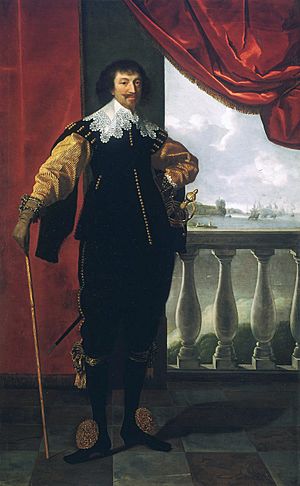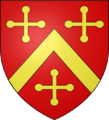Robert Rich, 2nd Earl of Warwick facts for kids
Quick facts for kids
Earl of Warwick
|
|
|---|---|
 |
|
| Lord Lieutenant of Essex | |
| In office 1625–1642 |
|
| Governor of Guernsey | |
| In office 1643–1645 |
|
| Member of Parliament for Essex |
|
| In office April 1614 – June 1614 |
|
| Member of Parliament for Maldon |
|
| In office February 1610 – February 1611 |
|
| Personal details | |
| Born | May/June 1587 Leez Priory, Essex |
| Died | 18 April 1658 (aged 70) Holborn, London |
| Resting place | Holy Cross Church, Felsted |
| Spouses | Frances Hatton (m. 1605) Susan Rowe (m. c. 1625) Eleanor Wortley (m. 1646) |
| Children | 5, including Anne, Robert and Charles |
| Parents | Robert Rich, 1st Earl of Warwick Penelope Devereux |
| Alma mater | Emmanuel College, Cambridge |
| Military service | |
| Branch/service | Royal Navy |
| Rank | Admiral |
| Battles/wars | Wars of the Three Kingdoms |
Robert Rich, 2nd Earl of Warwick (born May or June 1587, died 19 April 1658) was an important English leader. He was a naval officer and politician. He led the navy for the Parliament during the Wars of the Three Kingdoms. Robert Rich was also a Puritan, which meant he followed a strict form of Protestantism.
Contents
Who Was Robert Rich?
Robert Rich was born in Essex, England. He was the eldest son of Robert Rich, 1st Earl of Warwick. His mother was Penelope Devereux. His family was well-known and connected to other powerful people.
His Family Life
Robert was one of seven children. He had two sisters, Essex and Lettice. His younger brother was Henry Rich. Robert also had several half-siblings. These children were raised as part of the Rich family.
Robert Rich married three times during his life. His first wife was Frances Hatton. They had five children together. These included Anne, Robert, and Charles. His second wife was Susan Rowe. His third wife was Eleanor Wortley. He did not have children with his second or third wives.
Early Adventures and Politics
Robert Rich became the Earl of Warwick in 1619. This happened after his father passed away. He was very interested in starting new colonies. These were settlements in other parts of the world.
Exploring New Lands
He joined companies that explored places like Guinea and New England. He also helped with the Virginia Company. This company started colonies in North America. One important colony was Bermuda, also called the Somers Isles. Bermuda was a good place for his ships to operate from.
He also helped set up the Providence Island colony. This colony was in the West Indies. His ships were involved in privateering. This meant they were private ships allowed to attack enemy ships.
A Key Moment in History
In 1619, a ship he sponsored, the White Lion, was involved in a major event. It attacked a Portuguese ship. The White Lion then sailed to Virginia. Its crew sold about 20 Africans to the settlers there. These people had been forced into slavery. This event was a sad and important moment. It marked the beginning of slavery in the English colonies in America.
His Political Role
Robert Rich also served in the English Parliament. He was a Member of Parliament for Maldon. Later, he represented Essex. He was a strong voice in politics.
Helping Build New Colonies
Robert Rich's Puritan beliefs made him different from the King's court. But it helped him connect with the New England colonies. In 1628, he helped get a special document for the Massachusetts Bay Colony. This document allowed the colony to be formed.
He also received land in Connecticut in 1631. He continued to manage the Somers Isles Company. He also ran the Providence Island Company. These companies helped new settlements grow.
Standing Up to the King
In England, Robert Rich disagreed with King Charles I. He opposed forced loans and taxes like "ship money." He also disliked the King's church policies. He signed a petition in 1640. This petition asked the King to call another parliament.
Many places in America are named after him. These include the Warwick River and Warwick County, Virginia. Warwick, Rhode Island and Warwick Parish in Bermuda are also named for him. The oldest school in Bermuda, Warwick Academy, was built on land he gave.
Role in the English Civil War
The English Civil War began in 1642. Robert Rich played a very important role. He was chosen to lead the Parliament's navy. This was a very powerful position.
Leading the Fleet
In 1643, he was put in charge of a group governing the colonies. He worked to ensure religious freedom in these colonies. As the navy commander, he helped Parliament take back important castles in 1648. These were the 'Castles of the Downs' in Kent.
He was a close friend of Oliver Cromwell. Cromwell was the leader of Parliament's army. Cromwell's daughter married Robert Rich's grandson. Robert Rich retired from public life in 1649. This was when the House of Lords was abolished. He died in 1658.
Images for kids
-
Captain John Smith's 1624 map of Bermuda, showing Warwick Parish (3) and contemporary fortifications, including at Castle Harbour (originally "Southampton Port") where the ship Warwick was lost in 1619
-
Robert Rich, 2nd Earl of Warwick, portrait by Anthony van Dyck




